Business Research Methodology (PDF)
VerifiedAdded on 2021/05/31
|17
|3851
|42
AI Summary
Contribute Materials
Your contribution can guide someone’s learning journey. Share your
documents today.

Running head: BUSINESS RESEARCH METHODOLOGY
Challenges in Managing Global Teams
Name of the University:
Name of the Student:
Author Note:
Challenges in Managing Global Teams
Name of the University:
Name of the Student:
Author Note:
Secure Best Marks with AI Grader
Need help grading? Try our AI Grader for instant feedback on your assignments.
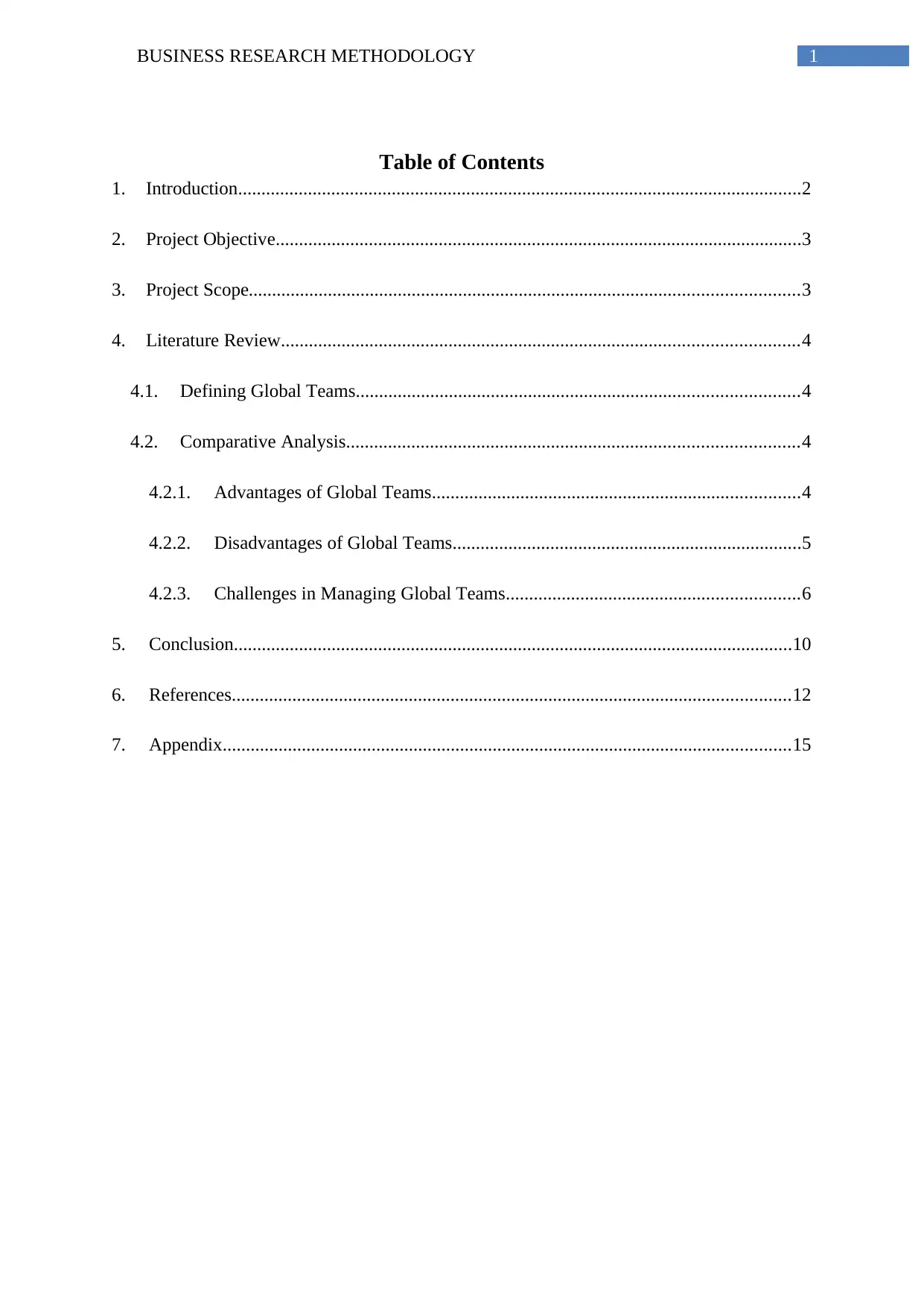
1BUSINESS RESEARCH METHODOLOGY
Table of Contents
1. Introduction.........................................................................................................................2
2. Project Objective.................................................................................................................3
3. Project Scope......................................................................................................................3
4. Literature Review...............................................................................................................4
4.1. Defining Global Teams...............................................................................................4
4.2. Comparative Analysis.................................................................................................4
4.2.1. Advantages of Global Teams...............................................................................4
4.2.2. Disadvantages of Global Teams...........................................................................5
4.2.3. Challenges in Managing Global Teams...............................................................6
5. Conclusion........................................................................................................................10
6. References........................................................................................................................12
7. Appendix..........................................................................................................................15
Table of Contents
1. Introduction.........................................................................................................................2
2. Project Objective.................................................................................................................3
3. Project Scope......................................................................................................................3
4. Literature Review...............................................................................................................4
4.1. Defining Global Teams...............................................................................................4
4.2. Comparative Analysis.................................................................................................4
4.2.1. Advantages of Global Teams...............................................................................4
4.2.2. Disadvantages of Global Teams...........................................................................5
4.2.3. Challenges in Managing Global Teams...............................................................6
5. Conclusion........................................................................................................................10
6. References........................................................................................................................12
7. Appendix..........................................................................................................................15
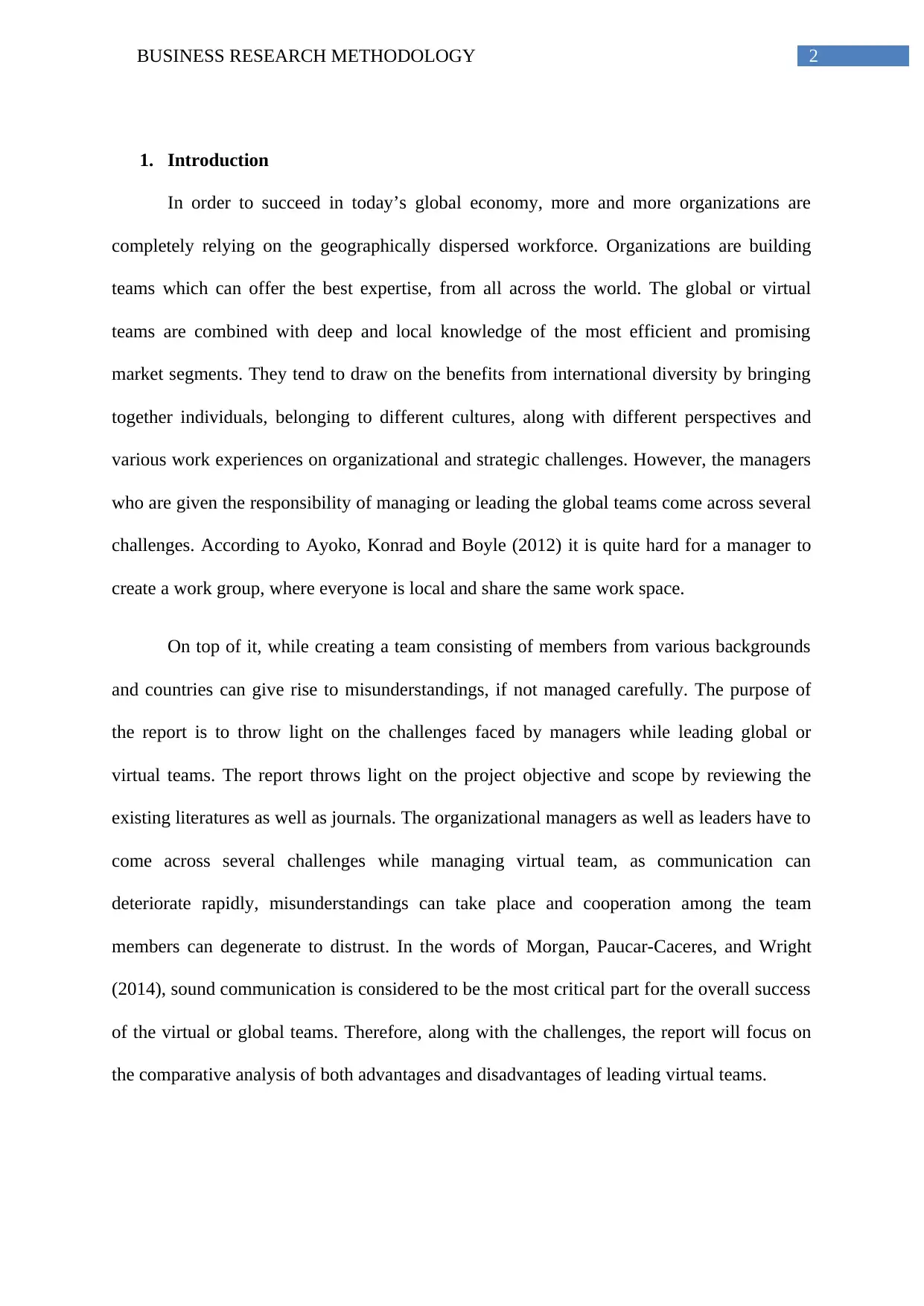
2BUSINESS RESEARCH METHODOLOGY
1. Introduction
In order to succeed in today’s global economy, more and more organizations are
completely relying on the geographically dispersed workforce. Organizations are building
teams which can offer the best expertise, from all across the world. The global or virtual
teams are combined with deep and local knowledge of the most efficient and promising
market segments. They tend to draw on the benefits from international diversity by bringing
together individuals, belonging to different cultures, along with different perspectives and
various work experiences on organizational and strategic challenges. However, the managers
who are given the responsibility of managing or leading the global teams come across several
challenges. According to Ayoko, Konrad and Boyle (2012) it is quite hard for a manager to
create a work group, where everyone is local and share the same work space.
On top of it, while creating a team consisting of members from various backgrounds
and countries can give rise to misunderstandings, if not managed carefully. The purpose of
the report is to throw light on the challenges faced by managers while leading global or
virtual teams. The report throws light on the project objective and scope by reviewing the
existing literatures as well as journals. The organizational managers as well as leaders have to
come across several challenges while managing virtual team, as communication can
deteriorate rapidly, misunderstandings can take place and cooperation among the team
members can degenerate to distrust. In the words of Morgan, Paucar-Caceres, and Wright
(2014), sound communication is considered to be the most critical part for the overall success
of the virtual or global teams. Therefore, along with the challenges, the report will focus on
the comparative analysis of both advantages and disadvantages of leading virtual teams.
1. Introduction
In order to succeed in today’s global economy, more and more organizations are
completely relying on the geographically dispersed workforce. Organizations are building
teams which can offer the best expertise, from all across the world. The global or virtual
teams are combined with deep and local knowledge of the most efficient and promising
market segments. They tend to draw on the benefits from international diversity by bringing
together individuals, belonging to different cultures, along with different perspectives and
various work experiences on organizational and strategic challenges. However, the managers
who are given the responsibility of managing or leading the global teams come across several
challenges. According to Ayoko, Konrad and Boyle (2012) it is quite hard for a manager to
create a work group, where everyone is local and share the same work space.
On top of it, while creating a team consisting of members from various backgrounds
and countries can give rise to misunderstandings, if not managed carefully. The purpose of
the report is to throw light on the challenges faced by managers while leading global or
virtual teams. The report throws light on the project objective and scope by reviewing the
existing literatures as well as journals. The organizational managers as well as leaders have to
come across several challenges while managing virtual team, as communication can
deteriorate rapidly, misunderstandings can take place and cooperation among the team
members can degenerate to distrust. In the words of Morgan, Paucar-Caceres, and Wright
(2014), sound communication is considered to be the most critical part for the overall success
of the virtual or global teams. Therefore, along with the challenges, the report will focus on
the comparative analysis of both advantages and disadvantages of leading virtual teams.
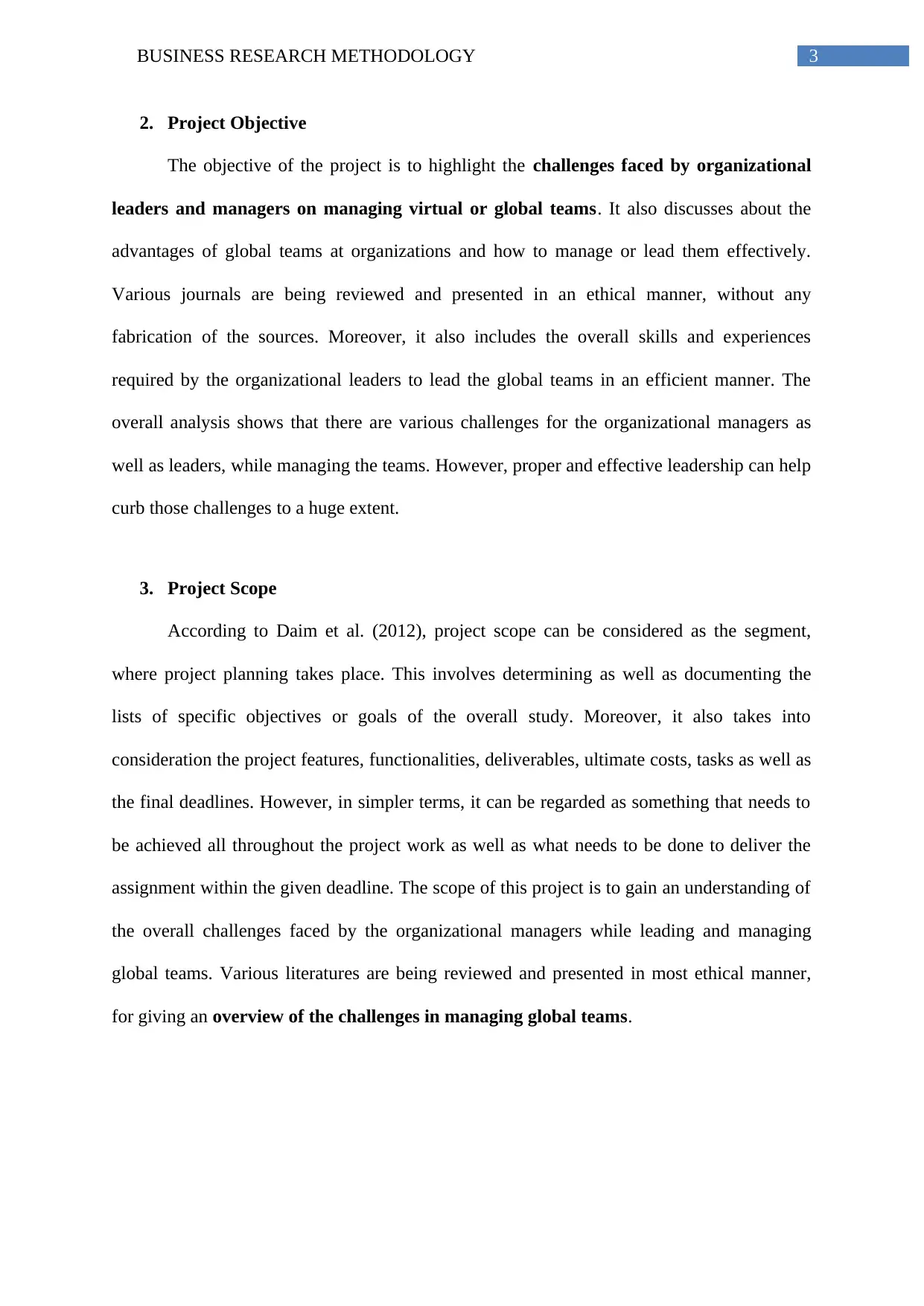
3BUSINESS RESEARCH METHODOLOGY
2. Project Objective
The objective of the project is to highlight the challenges faced by organizational
leaders and managers on managing virtual or global teams. It also discusses about the
advantages of global teams at organizations and how to manage or lead them effectively.
Various journals are being reviewed and presented in an ethical manner, without any
fabrication of the sources. Moreover, it also includes the overall skills and experiences
required by the organizational leaders to lead the global teams in an efficient manner. The
overall analysis shows that there are various challenges for the organizational managers as
well as leaders, while managing the teams. However, proper and effective leadership can help
curb those challenges to a huge extent.
3. Project Scope
According to Daim et al. (2012), project scope can be considered as the segment,
where project planning takes place. This involves determining as well as documenting the
lists of specific objectives or goals of the overall study. Moreover, it also takes into
consideration the project features, functionalities, deliverables, ultimate costs, tasks as well as
the final deadlines. However, in simpler terms, it can be regarded as something that needs to
be achieved all throughout the project work as well as what needs to be done to deliver the
assignment within the given deadline. The scope of this project is to gain an understanding of
the overall challenges faced by the organizational managers while leading and managing
global teams. Various literatures are being reviewed and presented in most ethical manner,
for giving an overview of the challenges in managing global teams.
2. Project Objective
The objective of the project is to highlight the challenges faced by organizational
leaders and managers on managing virtual or global teams. It also discusses about the
advantages of global teams at organizations and how to manage or lead them effectively.
Various journals are being reviewed and presented in an ethical manner, without any
fabrication of the sources. Moreover, it also includes the overall skills and experiences
required by the organizational leaders to lead the global teams in an efficient manner. The
overall analysis shows that there are various challenges for the organizational managers as
well as leaders, while managing the teams. However, proper and effective leadership can help
curb those challenges to a huge extent.
3. Project Scope
According to Daim et al. (2012), project scope can be considered as the segment,
where project planning takes place. This involves determining as well as documenting the
lists of specific objectives or goals of the overall study. Moreover, it also takes into
consideration the project features, functionalities, deliverables, ultimate costs, tasks as well as
the final deadlines. However, in simpler terms, it can be regarded as something that needs to
be achieved all throughout the project work as well as what needs to be done to deliver the
assignment within the given deadline. The scope of this project is to gain an understanding of
the overall challenges faced by the organizational managers while leading and managing
global teams. Various literatures are being reviewed and presented in most ethical manner,
for giving an overview of the challenges in managing global teams.
Secure Best Marks with AI Grader
Need help grading? Try our AI Grader for instant feedback on your assignments.
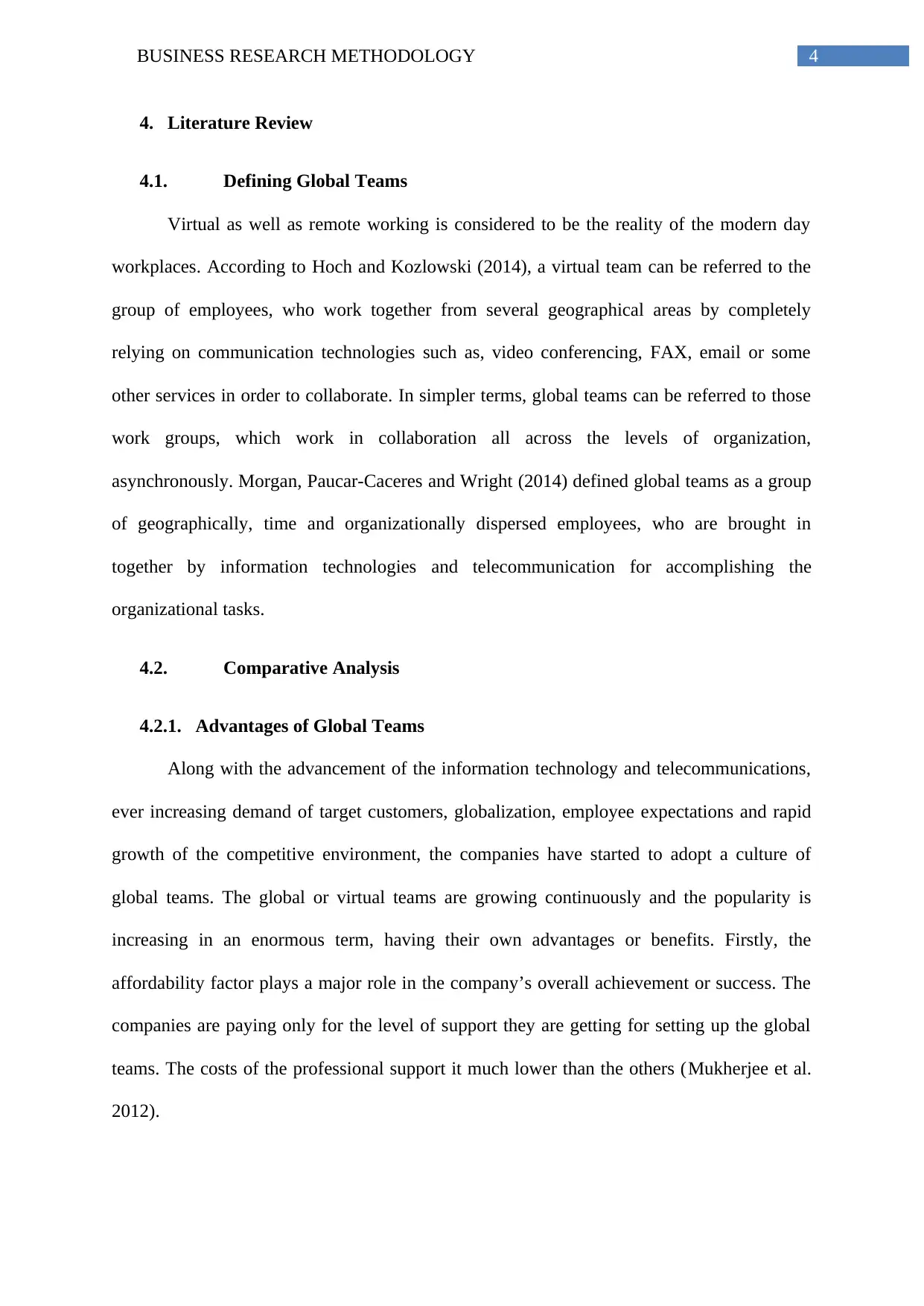
4BUSINESS RESEARCH METHODOLOGY
4. Literature Review
4.1. Defining Global Teams
Virtual as well as remote working is considered to be the reality of the modern day
workplaces. According to Hoch and Kozlowski (2014), a virtual team can be referred to the
group of employees, who work together from several geographical areas by completely
relying on communication technologies such as, video conferencing, FAX, email or some
other services in order to collaborate. In simpler terms, global teams can be referred to those
work groups, which work in collaboration all across the levels of organization,
asynchronously. Morgan, Paucar-Caceres and Wright (2014) defined global teams as a group
of geographically, time and organizationally dispersed employees, who are brought in
together by information technologies and telecommunication for accomplishing the
organizational tasks.
4.2. Comparative Analysis
4.2.1. Advantages of Global Teams
Along with the advancement of the information technology and telecommunications,
ever increasing demand of target customers, globalization, employee expectations and rapid
growth of the competitive environment, the companies have started to adopt a culture of
global teams. The global or virtual teams are growing continuously and the popularity is
increasing in an enormous term, having their own advantages or benefits. Firstly, the
affordability factor plays a major role in the company’s overall achievement or success. The
companies are paying only for the level of support they are getting for setting up the global
teams. The costs of the professional support it much lower than the others (Mukherjee et al.
2012).
4. Literature Review
4.1. Defining Global Teams
Virtual as well as remote working is considered to be the reality of the modern day
workplaces. According to Hoch and Kozlowski (2014), a virtual team can be referred to the
group of employees, who work together from several geographical areas by completely
relying on communication technologies such as, video conferencing, FAX, email or some
other services in order to collaborate. In simpler terms, global teams can be referred to those
work groups, which work in collaboration all across the levels of organization,
asynchronously. Morgan, Paucar-Caceres and Wright (2014) defined global teams as a group
of geographically, time and organizationally dispersed employees, who are brought in
together by information technologies and telecommunication for accomplishing the
organizational tasks.
4.2. Comparative Analysis
4.2.1. Advantages of Global Teams
Along with the advancement of the information technology and telecommunications,
ever increasing demand of target customers, globalization, employee expectations and rapid
growth of the competitive environment, the companies have started to adopt a culture of
global teams. The global or virtual teams are growing continuously and the popularity is
increasing in an enormous term, having their own advantages or benefits. Firstly, the
affordability factor plays a major role in the company’s overall achievement or success. The
companies are paying only for the level of support they are getting for setting up the global
teams. The costs of the professional support it much lower than the others (Mukherjee et al.
2012).

5BUSINESS RESEARCH METHODOLOGY
According to Binder (2016), there are no such overhead costs for the associate
services like computer, office space, communication lines between the in-house staff
members and virtual teams. Moreover, apart than the mentioned factors, the organizations are
being able to provide the global teams with right amount of flexible support. They can
identify the requirements easily, such as the need for any senior compensation analyst or say,
junior recruiter and others. The global teams need to fill up the requirements of the
companies and set their length of the services.
4.2.2. Disadvantages of Global Teams
Along with advantages, come various disadvantages as well, which may give a
different concept of the global teams. In the words of Goetsch and Davis (2014), there are
certain challenges or disadvantages on leading or managing the global teams. In order to
become more successful and efficient, the organizations should clearly gain an understanding
of the challenges, which are inherent in the global teams. This can be easily done by avoiding
those mistakes that lead to nothing, except failure. These challenges cover various areas such
as poor management, poor leadership as well as poor communication. As per Carter et al.
(2015), communication is a major factor here due to the physical location of the employees.
However, Lasserre (2017) stated that the organizations as well as companies have the
potential of leveraging the technologies for reducing this major issue by video conferencing,
phone discussions, detailed email updates and project management software. It can be said
that poor management as well as leadership can affect the idea of virtual or global teams. It is
immensely important for the organizational global team leaders to have the skills and
experiences of managing global employees. It is important for the leaders to take certain
initiatives so that the employees have a clear vision of organizational objectives or goals.
According to Binder (2016), there are no such overhead costs for the associate
services like computer, office space, communication lines between the in-house staff
members and virtual teams. Moreover, apart than the mentioned factors, the organizations are
being able to provide the global teams with right amount of flexible support. They can
identify the requirements easily, such as the need for any senior compensation analyst or say,
junior recruiter and others. The global teams need to fill up the requirements of the
companies and set their length of the services.
4.2.2. Disadvantages of Global Teams
Along with advantages, come various disadvantages as well, which may give a
different concept of the global teams. In the words of Goetsch and Davis (2014), there are
certain challenges or disadvantages on leading or managing the global teams. In order to
become more successful and efficient, the organizations should clearly gain an understanding
of the challenges, which are inherent in the global teams. This can be easily done by avoiding
those mistakes that lead to nothing, except failure. These challenges cover various areas such
as poor management, poor leadership as well as poor communication. As per Carter et al.
(2015), communication is a major factor here due to the physical location of the employees.
However, Lasserre (2017) stated that the organizations as well as companies have the
potential of leveraging the technologies for reducing this major issue by video conferencing,
phone discussions, detailed email updates and project management software. It can be said
that poor management as well as leadership can affect the idea of virtual or global teams. It is
immensely important for the organizational global team leaders to have the skills and
experiences of managing global employees. It is important for the leaders to take certain
initiatives so that the employees have a clear vision of organizational objectives or goals.
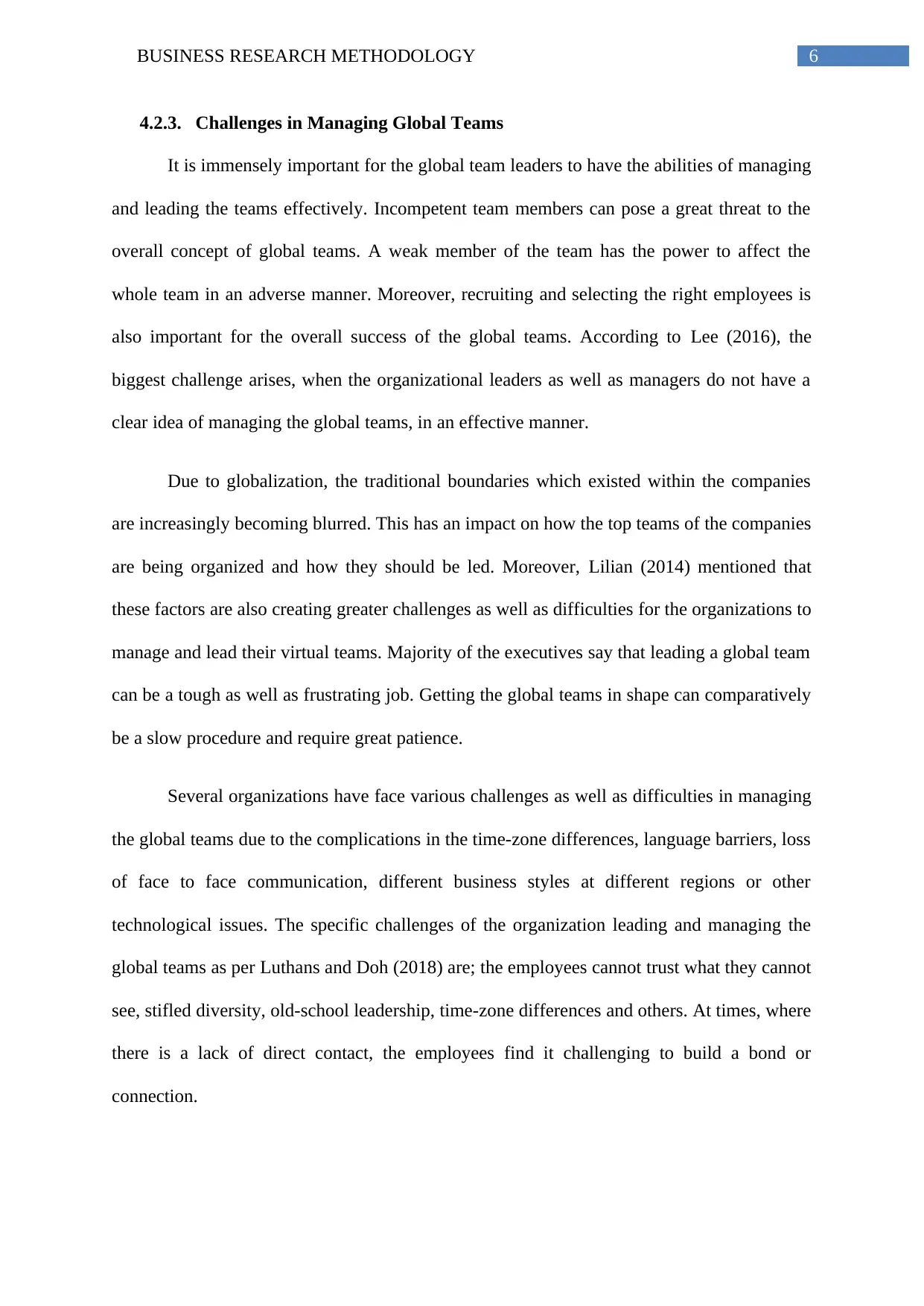
6BUSINESS RESEARCH METHODOLOGY
4.2.3. Challenges in Managing Global Teams
It is immensely important for the global team leaders to have the abilities of managing
and leading the teams effectively. Incompetent team members can pose a great threat to the
overall concept of global teams. A weak member of the team has the power to affect the
whole team in an adverse manner. Moreover, recruiting and selecting the right employees is
also important for the overall success of the global teams. According to Lee (2016), the
biggest challenge arises, when the organizational leaders as well as managers do not have a
clear idea of managing the global teams, in an effective manner.
Due to globalization, the traditional boundaries which existed within the companies
are increasingly becoming blurred. This has an impact on how the top teams of the companies
are being organized and how they should be led. Moreover, Lilian (2014) mentioned that
these factors are also creating greater challenges as well as difficulties for the organizations to
manage and lead their virtual teams. Majority of the executives say that leading a global team
can be a tough as well as frustrating job. Getting the global teams in shape can comparatively
be a slow procedure and require great patience.
Several organizations have face various challenges as well as difficulties in managing
the global teams due to the complications in the time-zone differences, language barriers, loss
of face to face communication, different business styles at different regions or other
technological issues. The specific challenges of the organization leading and managing the
global teams as per Luthans and Doh (2018) are; the employees cannot trust what they cannot
see, stifled diversity, old-school leadership, time-zone differences and others. At times, where
there is a lack of direct contact, the employees find it challenging to build a bond or
connection.
4.2.3. Challenges in Managing Global Teams
It is immensely important for the global team leaders to have the abilities of managing
and leading the teams effectively. Incompetent team members can pose a great threat to the
overall concept of global teams. A weak member of the team has the power to affect the
whole team in an adverse manner. Moreover, recruiting and selecting the right employees is
also important for the overall success of the global teams. According to Lee (2016), the
biggest challenge arises, when the organizational leaders as well as managers do not have a
clear idea of managing the global teams, in an effective manner.
Due to globalization, the traditional boundaries which existed within the companies
are increasingly becoming blurred. This has an impact on how the top teams of the companies
are being organized and how they should be led. Moreover, Lilian (2014) mentioned that
these factors are also creating greater challenges as well as difficulties for the organizations to
manage and lead their virtual teams. Majority of the executives say that leading a global team
can be a tough as well as frustrating job. Getting the global teams in shape can comparatively
be a slow procedure and require great patience.
Several organizations have face various challenges as well as difficulties in managing
the global teams due to the complications in the time-zone differences, language barriers, loss
of face to face communication, different business styles at different regions or other
technological issues. The specific challenges of the organization leading and managing the
global teams as per Luthans and Doh (2018) are; the employees cannot trust what they cannot
see, stifled diversity, old-school leadership, time-zone differences and others. At times, where
there is a lack of direct contact, the employees find it challenging to build a bond or
connection.
Paraphrase This Document
Need a fresh take? Get an instant paraphrase of this document with our AI Paraphraser
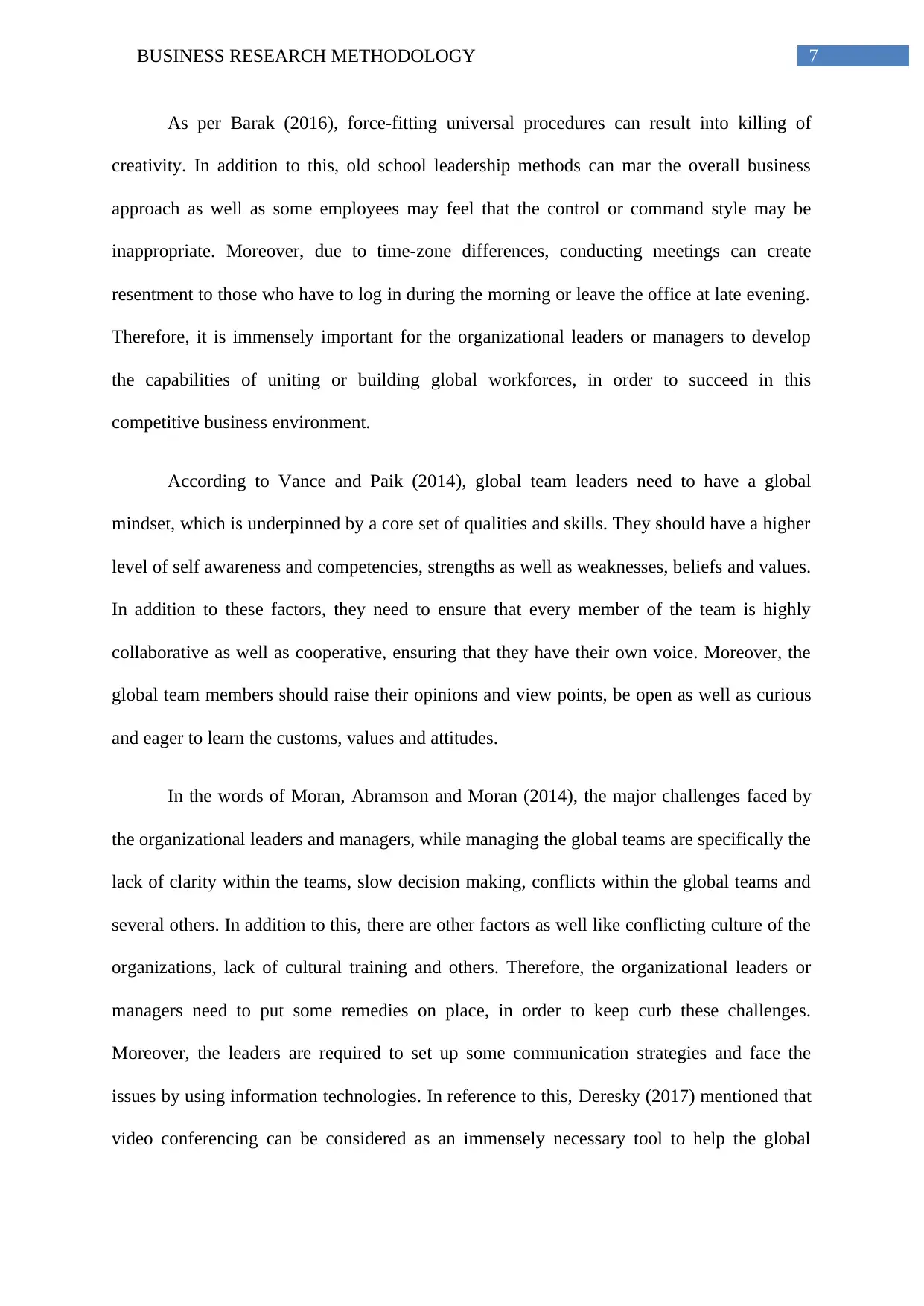
7BUSINESS RESEARCH METHODOLOGY
As per Barak (2016), force-fitting universal procedures can result into killing of
creativity. In addition to this, old school leadership methods can mar the overall business
approach as well as some employees may feel that the control or command style may be
inappropriate. Moreover, due to time-zone differences, conducting meetings can create
resentment to those who have to log in during the morning or leave the office at late evening.
Therefore, it is immensely important for the organizational leaders or managers to develop
the capabilities of uniting or building global workforces, in order to succeed in this
competitive business environment.
According to Vance and Paik (2014), global team leaders need to have a global
mindset, which is underpinned by a core set of qualities and skills. They should have a higher
level of self awareness and competencies, strengths as well as weaknesses, beliefs and values.
In addition to these factors, they need to ensure that every member of the team is highly
collaborative as well as cooperative, ensuring that they have their own voice. Moreover, the
global team members should raise their opinions and view points, be open as well as curious
and eager to learn the customs, values and attitudes.
In the words of Moran, Abramson and Moran (2014), the major challenges faced by
the organizational leaders and managers, while managing the global teams are specifically the
lack of clarity within the teams, slow decision making, conflicts within the global teams and
several others. In addition to this, there are other factors as well like conflicting culture of the
organizations, lack of cultural training and others. Therefore, the organizational leaders or
managers need to put some remedies on place, in order to keep curb these challenges.
Moreover, the leaders are required to set up some communication strategies and face the
issues by using information technologies. In reference to this, Deresky (2017) mentioned that
video conferencing can be considered as an immensely necessary tool to help the global
As per Barak (2016), force-fitting universal procedures can result into killing of
creativity. In addition to this, old school leadership methods can mar the overall business
approach as well as some employees may feel that the control or command style may be
inappropriate. Moreover, due to time-zone differences, conducting meetings can create
resentment to those who have to log in during the morning or leave the office at late evening.
Therefore, it is immensely important for the organizational leaders or managers to develop
the capabilities of uniting or building global workforces, in order to succeed in this
competitive business environment.
According to Vance and Paik (2014), global team leaders need to have a global
mindset, which is underpinned by a core set of qualities and skills. They should have a higher
level of self awareness and competencies, strengths as well as weaknesses, beliefs and values.
In addition to these factors, they need to ensure that every member of the team is highly
collaborative as well as cooperative, ensuring that they have their own voice. Moreover, the
global team members should raise their opinions and view points, be open as well as curious
and eager to learn the customs, values and attitudes.
In the words of Moran, Abramson and Moran (2014), the major challenges faced by
the organizational leaders and managers, while managing the global teams are specifically the
lack of clarity within the teams, slow decision making, conflicts within the global teams and
several others. In addition to this, there are other factors as well like conflicting culture of the
organizations, lack of cultural training and others. Therefore, the organizational leaders or
managers need to put some remedies on place, in order to keep curb these challenges.
Moreover, the leaders are required to set up some communication strategies and face the
issues by using information technologies. In reference to this, Deresky (2017) mentioned that
video conferencing can be considered as an immensely necessary tool to help the global

8BUSINESS RESEARCH METHODOLOGY
teams feel ‘present’ within the meetings. It will help the participants by giving them the
abilities of sensing each other’s tone and body language as well.
As per Maranga’s and Sampayo’s (2015) opinion, one of the major challenges for the
global teams is the noticeable disconnection between the international staffs and central
management. According to the researchers, around 58% of international managers are not
properly equipped to lead the cultural or global teams. According to the managers of the
international companies, around 96% of them felt that they face several challenges, while
managing and leading the virtual teams. They stated that global teams are more difficult to
handle and majority of the challenges arise due to the disconnection between the managers
and the team members’ opinions.
According to a survey conducted by the RW Culture Wizard, around 38% of the
disconnections between the opinions of the staff members and the global team leaders or
managers occur due to ineffective communication. Therefore, it can be said that the biggest
reasons for ineffective global teams is the disconnection in the corporate communication,
which leads to the specified challenges. The managers or leaders do not a have a clear idea or
concept of the pre-required communication forms or infrastructures required for handling
global teams in an effective, yet efficient manner (Reilly and Williams 2016).
In addition to this, according to Cascio and Boudreau (2016), another major reason
for the disconnection of the virtual team managers and their employees can be the cultural
differences. In fact, around 70% of the respondents in a survey reported that due to the
cultural differences that exist within the international organizations, employees are facing
huge difficulties in keeping the performance level higher. This factor proves to be a major
challenge for the international organizations and therefore, proper leadership and
teams feel ‘present’ within the meetings. It will help the participants by giving them the
abilities of sensing each other’s tone and body language as well.
As per Maranga’s and Sampayo’s (2015) opinion, one of the major challenges for the
global teams is the noticeable disconnection between the international staffs and central
management. According to the researchers, around 58% of international managers are not
properly equipped to lead the cultural or global teams. According to the managers of the
international companies, around 96% of them felt that they face several challenges, while
managing and leading the virtual teams. They stated that global teams are more difficult to
handle and majority of the challenges arise due to the disconnection between the managers
and the team members’ opinions.
According to a survey conducted by the RW Culture Wizard, around 38% of the
disconnections between the opinions of the staff members and the global team leaders or
managers occur due to ineffective communication. Therefore, it can be said that the biggest
reasons for ineffective global teams is the disconnection in the corporate communication,
which leads to the specified challenges. The managers or leaders do not a have a clear idea or
concept of the pre-required communication forms or infrastructures required for handling
global teams in an effective, yet efficient manner (Reilly and Williams 2016).
In addition to this, according to Cascio and Boudreau (2016), another major reason
for the disconnection of the virtual team managers and their employees can be the cultural
differences. In fact, around 70% of the respondents in a survey reported that due to the
cultural differences that exist within the international organizations, employees are facing
huge difficulties in keeping the performance level higher. This factor proves to be a major
challenge for the international organizations and therefore, proper leadership and
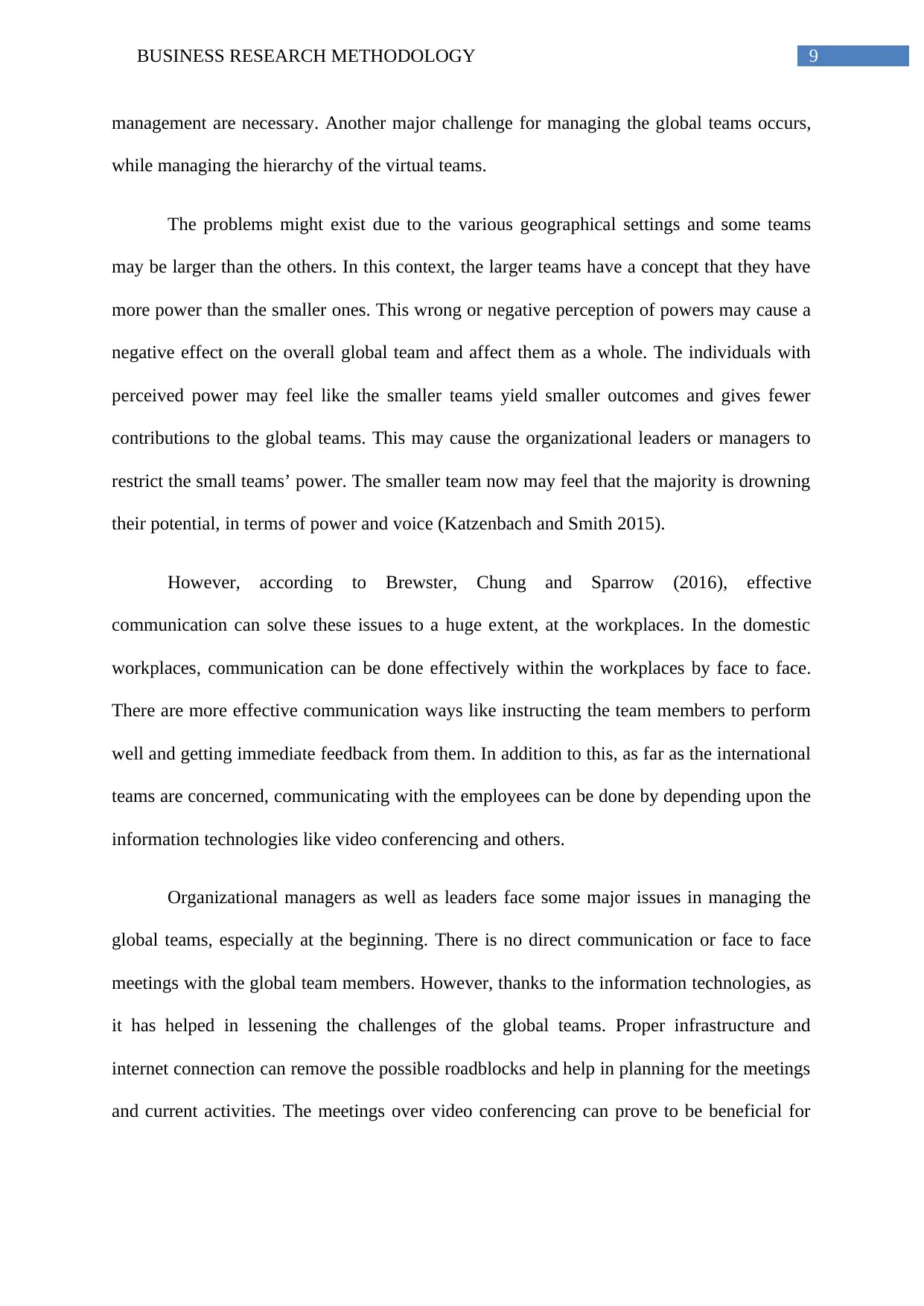
9BUSINESS RESEARCH METHODOLOGY
management are necessary. Another major challenge for managing the global teams occurs,
while managing the hierarchy of the virtual teams.
The problems might exist due to the various geographical settings and some teams
may be larger than the others. In this context, the larger teams have a concept that they have
more power than the smaller ones. This wrong or negative perception of powers may cause a
negative effect on the overall global team and affect them as a whole. The individuals with
perceived power may feel like the smaller teams yield smaller outcomes and gives fewer
contributions to the global teams. This may cause the organizational leaders or managers to
restrict the small teams’ power. The smaller team now may feel that the majority is drowning
their potential, in terms of power and voice (Katzenbach and Smith 2015).
However, according to Brewster, Chung and Sparrow (2016), effective
communication can solve these issues to a huge extent, at the workplaces. In the domestic
workplaces, communication can be done effectively within the workplaces by face to face.
There are more effective communication ways like instructing the team members to perform
well and getting immediate feedback from them. In addition to this, as far as the international
teams are concerned, communicating with the employees can be done by depending upon the
information technologies like video conferencing and others.
Organizational managers as well as leaders face some major issues in managing the
global teams, especially at the beginning. There is no direct communication or face to face
meetings with the global team members. However, thanks to the information technologies, as
it has helped in lessening the challenges of the global teams. Proper infrastructure and
internet connection can remove the possible roadblocks and help in planning for the meetings
and current activities. The meetings over video conferencing can prove to be beneficial for
management are necessary. Another major challenge for managing the global teams occurs,
while managing the hierarchy of the virtual teams.
The problems might exist due to the various geographical settings and some teams
may be larger than the others. In this context, the larger teams have a concept that they have
more power than the smaller ones. This wrong or negative perception of powers may cause a
negative effect on the overall global team and affect them as a whole. The individuals with
perceived power may feel like the smaller teams yield smaller outcomes and gives fewer
contributions to the global teams. This may cause the organizational leaders or managers to
restrict the small teams’ power. The smaller team now may feel that the majority is drowning
their potential, in terms of power and voice (Katzenbach and Smith 2015).
However, according to Brewster, Chung and Sparrow (2016), effective
communication can solve these issues to a huge extent, at the workplaces. In the domestic
workplaces, communication can be done effectively within the workplaces by face to face.
There are more effective communication ways like instructing the team members to perform
well and getting immediate feedback from them. In addition to this, as far as the international
teams are concerned, communicating with the employees can be done by depending upon the
information technologies like video conferencing and others.
Organizational managers as well as leaders face some major issues in managing the
global teams, especially at the beginning. There is no direct communication or face to face
meetings with the global team members. However, thanks to the information technologies, as
it has helped in lessening the challenges of the global teams. Proper infrastructure and
internet connection can remove the possible roadblocks and help in planning for the meetings
and current activities. The meetings over video conferencing can prove to be beneficial for
Secure Best Marks with AI Grader
Need help grading? Try our AI Grader for instant feedback on your assignments.
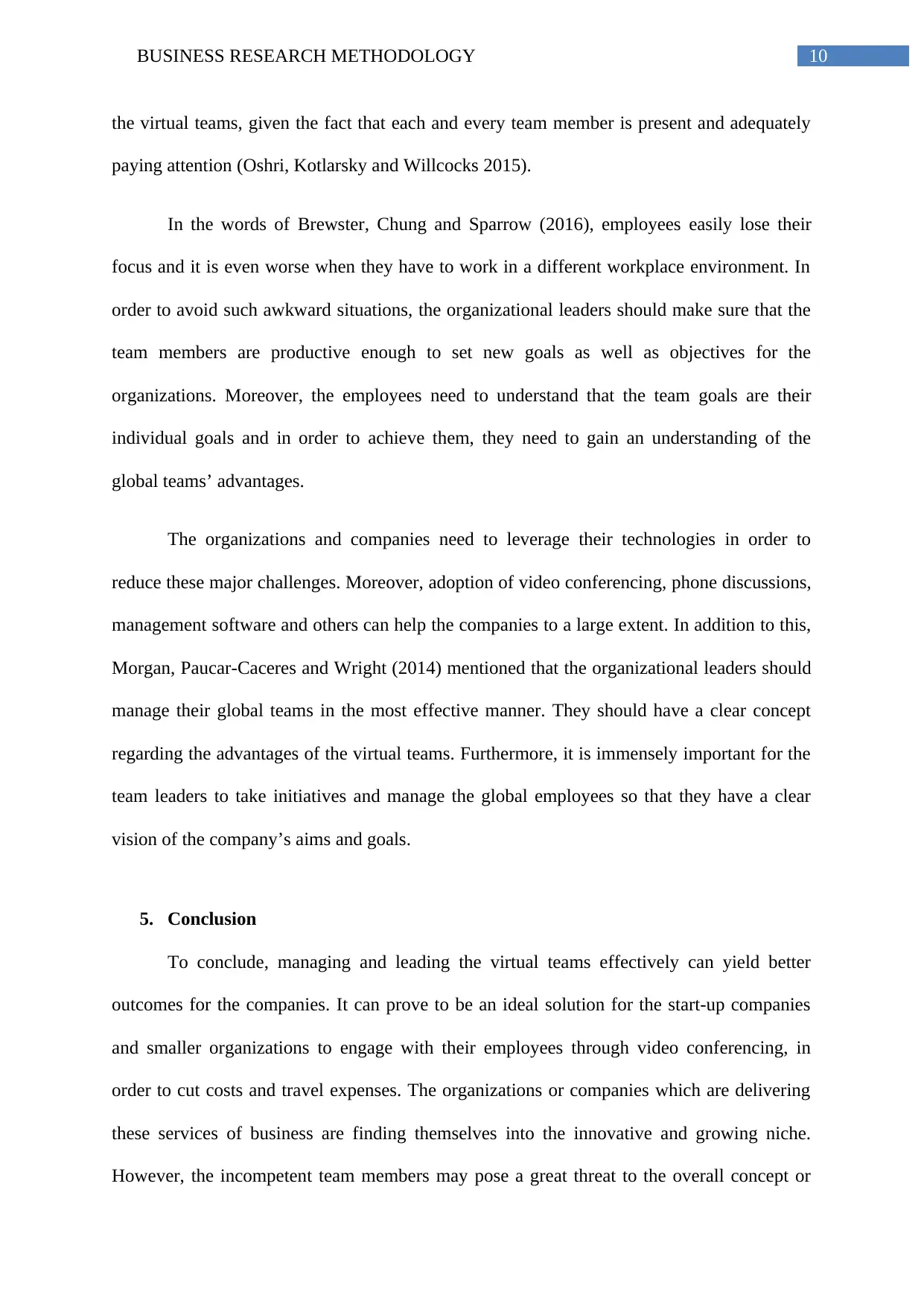
10BUSINESS RESEARCH METHODOLOGY
the virtual teams, given the fact that each and every team member is present and adequately
paying attention (Oshri, Kotlarsky and Willcocks 2015).
In the words of Brewster, Chung and Sparrow (2016), employees easily lose their
focus and it is even worse when they have to work in a different workplace environment. In
order to avoid such awkward situations, the organizational leaders should make sure that the
team members are productive enough to set new goals as well as objectives for the
organizations. Moreover, the employees need to understand that the team goals are their
individual goals and in order to achieve them, they need to gain an understanding of the
global teams’ advantages.
The organizations and companies need to leverage their technologies in order to
reduce these major challenges. Moreover, adoption of video conferencing, phone discussions,
management software and others can help the companies to a large extent. In addition to this,
Morgan, Paucar-Caceres and Wright (2014) mentioned that the organizational leaders should
manage their global teams in the most effective manner. They should have a clear concept
regarding the advantages of the virtual teams. Furthermore, it is immensely important for the
team leaders to take initiatives and manage the global employees so that they have a clear
vision of the company’s aims and goals.
5. Conclusion
To conclude, managing and leading the virtual teams effectively can yield better
outcomes for the companies. It can prove to be an ideal solution for the start-up companies
and smaller organizations to engage with their employees through video conferencing, in
order to cut costs and travel expenses. The organizations or companies which are delivering
these services of business are finding themselves into the innovative and growing niche.
However, the incompetent team members may pose a great threat to the overall concept or
the virtual teams, given the fact that each and every team member is present and adequately
paying attention (Oshri, Kotlarsky and Willcocks 2015).
In the words of Brewster, Chung and Sparrow (2016), employees easily lose their
focus and it is even worse when they have to work in a different workplace environment. In
order to avoid such awkward situations, the organizational leaders should make sure that the
team members are productive enough to set new goals as well as objectives for the
organizations. Moreover, the employees need to understand that the team goals are their
individual goals and in order to achieve them, they need to gain an understanding of the
global teams’ advantages.
The organizations and companies need to leverage their technologies in order to
reduce these major challenges. Moreover, adoption of video conferencing, phone discussions,
management software and others can help the companies to a large extent. In addition to this,
Morgan, Paucar-Caceres and Wright (2014) mentioned that the organizational leaders should
manage their global teams in the most effective manner. They should have a clear concept
regarding the advantages of the virtual teams. Furthermore, it is immensely important for the
team leaders to take initiatives and manage the global employees so that they have a clear
vision of the company’s aims and goals.
5. Conclusion
To conclude, managing and leading the virtual teams effectively can yield better
outcomes for the companies. It can prove to be an ideal solution for the start-up companies
and smaller organizations to engage with their employees through video conferencing, in
order to cut costs and travel expenses. The organizations or companies which are delivering
these services of business are finding themselves into the innovative and growing niche.
However, the incompetent team members may pose a great threat to the overall concept or
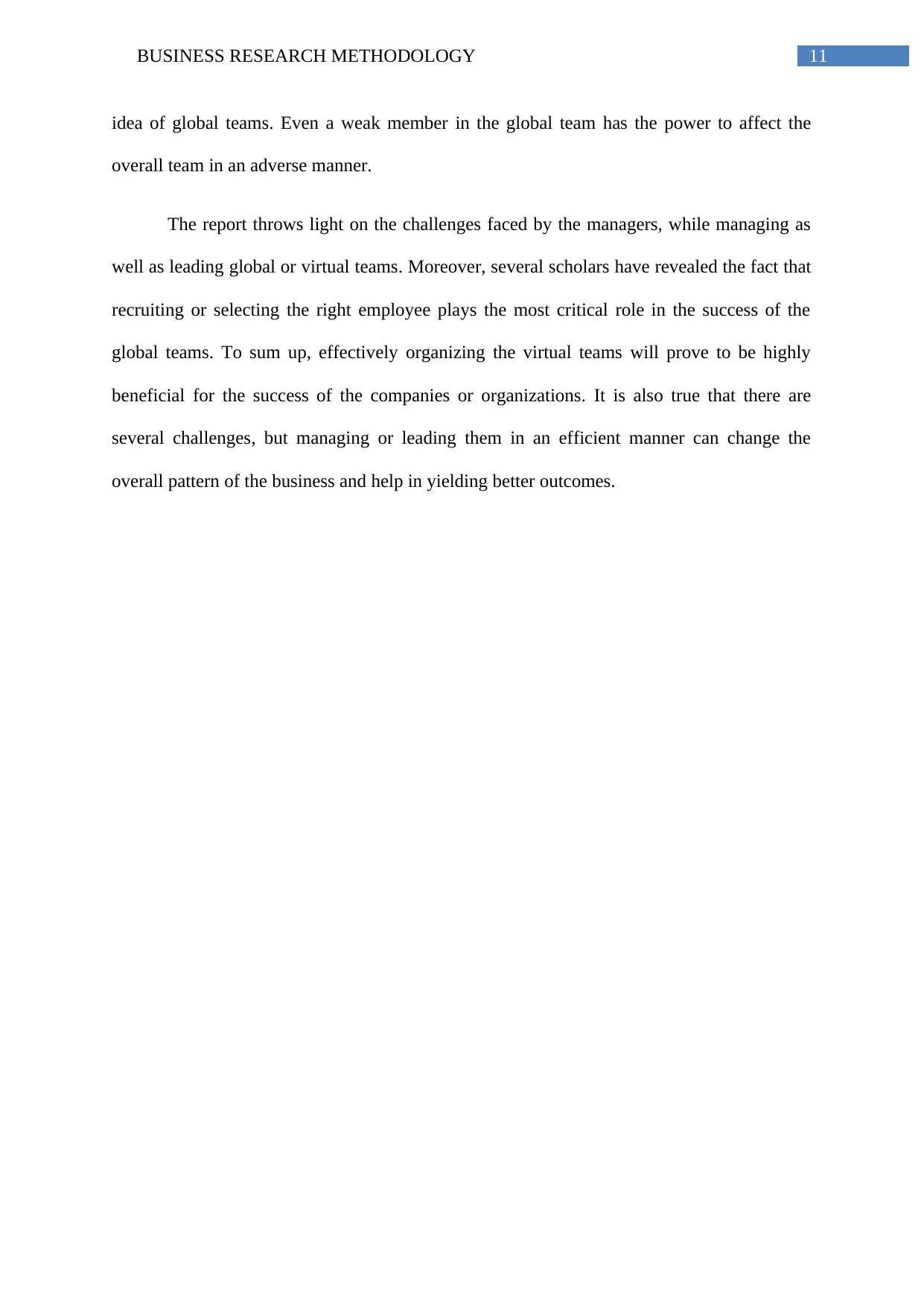
11BUSINESS RESEARCH METHODOLOGY
idea of global teams. Even a weak member in the global team has the power to affect the
overall team in an adverse manner.
The report throws light on the challenges faced by the managers, while managing as
well as leading global or virtual teams. Moreover, several scholars have revealed the fact that
recruiting or selecting the right employee plays the most critical role in the success of the
global teams. To sum up, effectively organizing the virtual teams will prove to be highly
beneficial for the success of the companies or organizations. It is also true that there are
several challenges, but managing or leading them in an efficient manner can change the
overall pattern of the business and help in yielding better outcomes.
idea of global teams. Even a weak member in the global team has the power to affect the
overall team in an adverse manner.
The report throws light on the challenges faced by the managers, while managing as
well as leading global or virtual teams. Moreover, several scholars have revealed the fact that
recruiting or selecting the right employee plays the most critical role in the success of the
global teams. To sum up, effectively organizing the virtual teams will prove to be highly
beneficial for the success of the companies or organizations. It is also true that there are
several challenges, but managing or leading them in an efficient manner can change the
overall pattern of the business and help in yielding better outcomes.
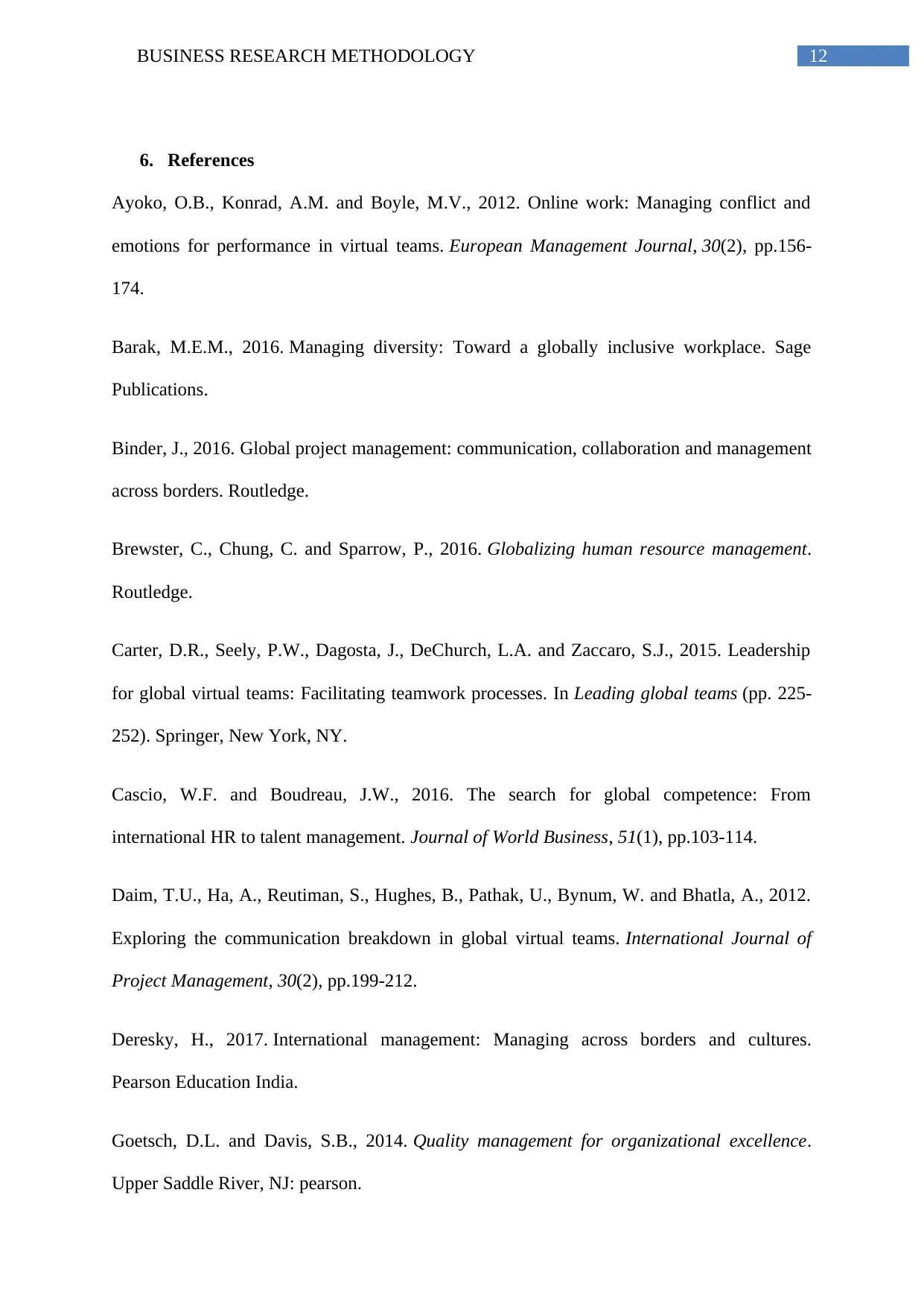
12BUSINESS RESEARCH METHODOLOGY
6. References
Ayoko, O.B., Konrad, A.M. and Boyle, M.V., 2012. Online work: Managing conflict and
emotions for performance in virtual teams. European Management Journal, 30(2), pp.156-
174.
Barak, M.E.M., 2016. Managing diversity: Toward a globally inclusive workplace. Sage
Publications.
Binder, J., 2016. Global project management: communication, collaboration and management
across borders. Routledge.
Brewster, C., Chung, C. and Sparrow, P., 2016. Globalizing human resource management.
Routledge.
Carter, D.R., Seely, P.W., Dagosta, J., DeChurch, L.A. and Zaccaro, S.J., 2015. Leadership
for global virtual teams: Facilitating teamwork processes. In Leading global teams (pp. 225-
252). Springer, New York, NY.
Cascio, W.F. and Boudreau, J.W., 2016. The search for global competence: From
international HR to talent management. Journal of World Business, 51(1), pp.103-114.
Daim, T.U., Ha, A., Reutiman, S., Hughes, B., Pathak, U., Bynum, W. and Bhatla, A., 2012.
Exploring the communication breakdown in global virtual teams. International Journal of
Project Management, 30(2), pp.199-212.
Deresky, H., 2017. International management: Managing across borders and cultures.
Pearson Education India.
Goetsch, D.L. and Davis, S.B., 2014. Quality management for organizational excellence.
Upper Saddle River, NJ: pearson.
6. References
Ayoko, O.B., Konrad, A.M. and Boyle, M.V., 2012. Online work: Managing conflict and
emotions for performance in virtual teams. European Management Journal, 30(2), pp.156-
174.
Barak, M.E.M., 2016. Managing diversity: Toward a globally inclusive workplace. Sage
Publications.
Binder, J., 2016. Global project management: communication, collaboration and management
across borders. Routledge.
Brewster, C., Chung, C. and Sparrow, P., 2016. Globalizing human resource management.
Routledge.
Carter, D.R., Seely, P.W., Dagosta, J., DeChurch, L.A. and Zaccaro, S.J., 2015. Leadership
for global virtual teams: Facilitating teamwork processes. In Leading global teams (pp. 225-
252). Springer, New York, NY.
Cascio, W.F. and Boudreau, J.W., 2016. The search for global competence: From
international HR to talent management. Journal of World Business, 51(1), pp.103-114.
Daim, T.U., Ha, A., Reutiman, S., Hughes, B., Pathak, U., Bynum, W. and Bhatla, A., 2012.
Exploring the communication breakdown in global virtual teams. International Journal of
Project Management, 30(2), pp.199-212.
Deresky, H., 2017. International management: Managing across borders and cultures.
Pearson Education India.
Goetsch, D.L. and Davis, S.B., 2014. Quality management for organizational excellence.
Upper Saddle River, NJ: pearson.
Paraphrase This Document
Need a fresh take? Get an instant paraphrase of this document with our AI Paraphraser
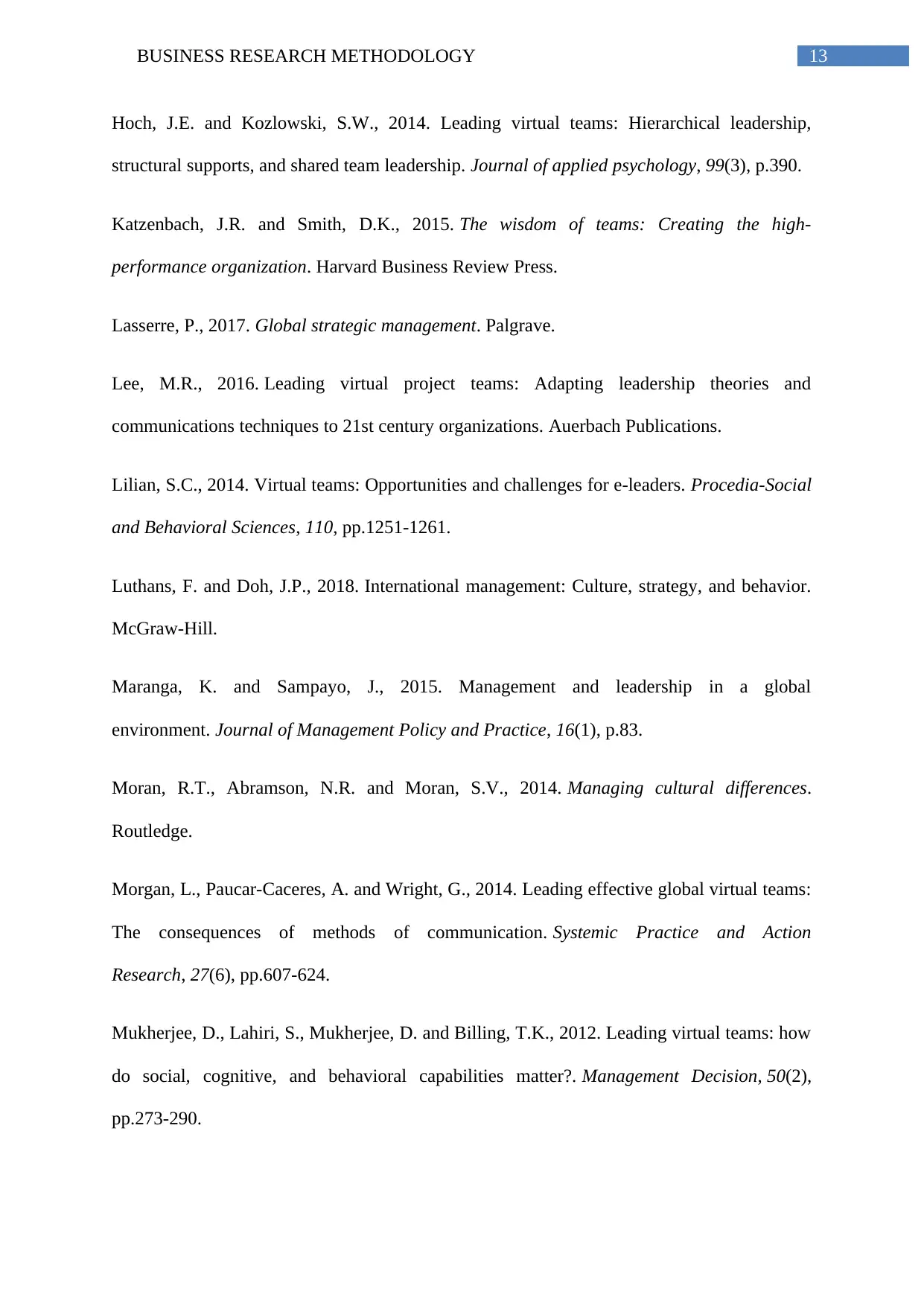
13BUSINESS RESEARCH METHODOLOGY
Hoch, J.E. and Kozlowski, S.W., 2014. Leading virtual teams: Hierarchical leadership,
structural supports, and shared team leadership. Journal of applied psychology, 99(3), p.390.
Katzenbach, J.R. and Smith, D.K., 2015. The wisdom of teams: Creating the high-
performance organization. Harvard Business Review Press.
Lasserre, P., 2017. Global strategic management. Palgrave.
Lee, M.R., 2016. Leading virtual project teams: Adapting leadership theories and
communications techniques to 21st century organizations. Auerbach Publications.
Lilian, S.C., 2014. Virtual teams: Opportunities and challenges for e-leaders. Procedia-Social
and Behavioral Sciences, 110, pp.1251-1261.
Luthans, F. and Doh, J.P., 2018. International management: Culture, strategy, and behavior.
McGraw-Hill.
Maranga, K. and Sampayo, J., 2015. Management and leadership in a global
environment. Journal of Management Policy and Practice, 16(1), p.83.
Moran, R.T., Abramson, N.R. and Moran, S.V., 2014. Managing cultural differences.
Routledge.
Morgan, L., Paucar-Caceres, A. and Wright, G., 2014. Leading effective global virtual teams:
The consequences of methods of communication. Systemic Practice and Action
Research, 27(6), pp.607-624.
Mukherjee, D., Lahiri, S., Mukherjee, D. and Billing, T.K., 2012. Leading virtual teams: how
do social, cognitive, and behavioral capabilities matter?. Management Decision, 50(2),
pp.273-290.
Hoch, J.E. and Kozlowski, S.W., 2014. Leading virtual teams: Hierarchical leadership,
structural supports, and shared team leadership. Journal of applied psychology, 99(3), p.390.
Katzenbach, J.R. and Smith, D.K., 2015. The wisdom of teams: Creating the high-
performance organization. Harvard Business Review Press.
Lasserre, P., 2017. Global strategic management. Palgrave.
Lee, M.R., 2016. Leading virtual project teams: Adapting leadership theories and
communications techniques to 21st century organizations. Auerbach Publications.
Lilian, S.C., 2014. Virtual teams: Opportunities and challenges for e-leaders. Procedia-Social
and Behavioral Sciences, 110, pp.1251-1261.
Luthans, F. and Doh, J.P., 2018. International management: Culture, strategy, and behavior.
McGraw-Hill.
Maranga, K. and Sampayo, J., 2015. Management and leadership in a global
environment. Journal of Management Policy and Practice, 16(1), p.83.
Moran, R.T., Abramson, N.R. and Moran, S.V., 2014. Managing cultural differences.
Routledge.
Morgan, L., Paucar-Caceres, A. and Wright, G., 2014. Leading effective global virtual teams:
The consequences of methods of communication. Systemic Practice and Action
Research, 27(6), pp.607-624.
Mukherjee, D., Lahiri, S., Mukherjee, D. and Billing, T.K., 2012. Leading virtual teams: how
do social, cognitive, and behavioral capabilities matter?. Management Decision, 50(2),
pp.273-290.

14BUSINESS RESEARCH METHODOLOGY
Oshri, I., Kotlarsky, J. and Willcocks, L.P., 2015. The Handbook of Global Outsourcing and
Offshoring 3rd Edition. Springer.
Reilly, P. and Williams, T., 2016. Global HR: Challenges facing the function. Routledge.
Vance, C.M. and Paik, Y., 2014. Managing a global workforce: challenges and opportunities
in international human resource management. Routledge.
Oshri, I., Kotlarsky, J. and Willcocks, L.P., 2015. The Handbook of Global Outsourcing and
Offshoring 3rd Edition. Springer.
Reilly, P. and Williams, T., 2016. Global HR: Challenges facing the function. Routledge.
Vance, C.M. and Paik, Y., 2014. Managing a global workforce: challenges and opportunities
in international human resource management. Routledge.
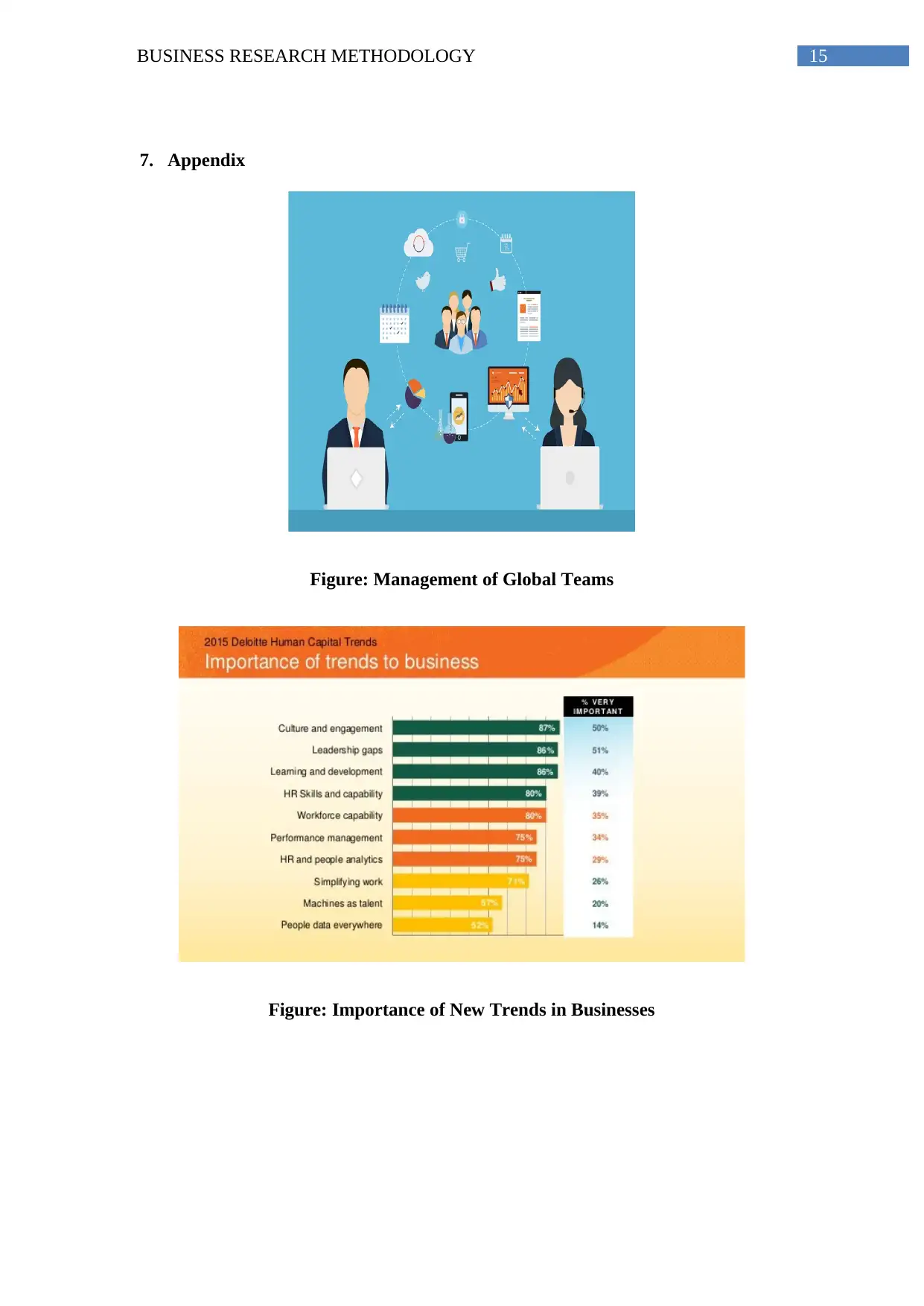
15BUSINESS RESEARCH METHODOLOGY
7. Appendix
Figure: Management of Global Teams
Figure: Importance of New Trends in Businesses
7. Appendix
Figure: Management of Global Teams
Figure: Importance of New Trends in Businesses
Secure Best Marks with AI Grader
Need help grading? Try our AI Grader for instant feedback on your assignments.
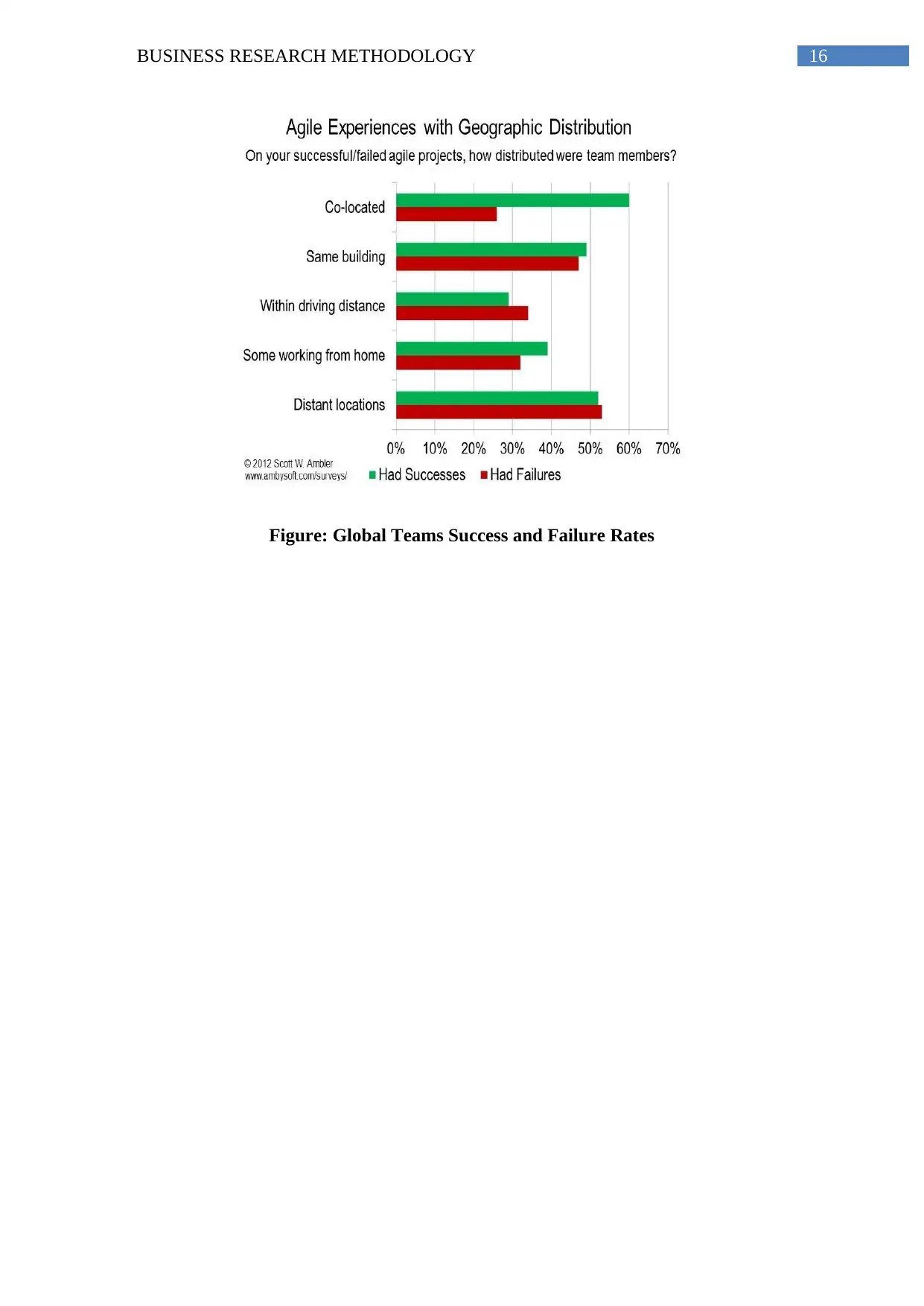
16BUSINESS RESEARCH METHODOLOGY
Figure: Global Teams Success and Failure Rates
Figure: Global Teams Success and Failure Rates
1 out of 17
Related Documents
Your All-in-One AI-Powered Toolkit for Academic Success.
+13062052269
info@desklib.com
Available 24*7 on WhatsApp / Email
![[object Object]](/_next/static/media/star-bottom.7253800d.svg)
Unlock your academic potential
© 2024 | Zucol Services PVT LTD | All rights reserved.





